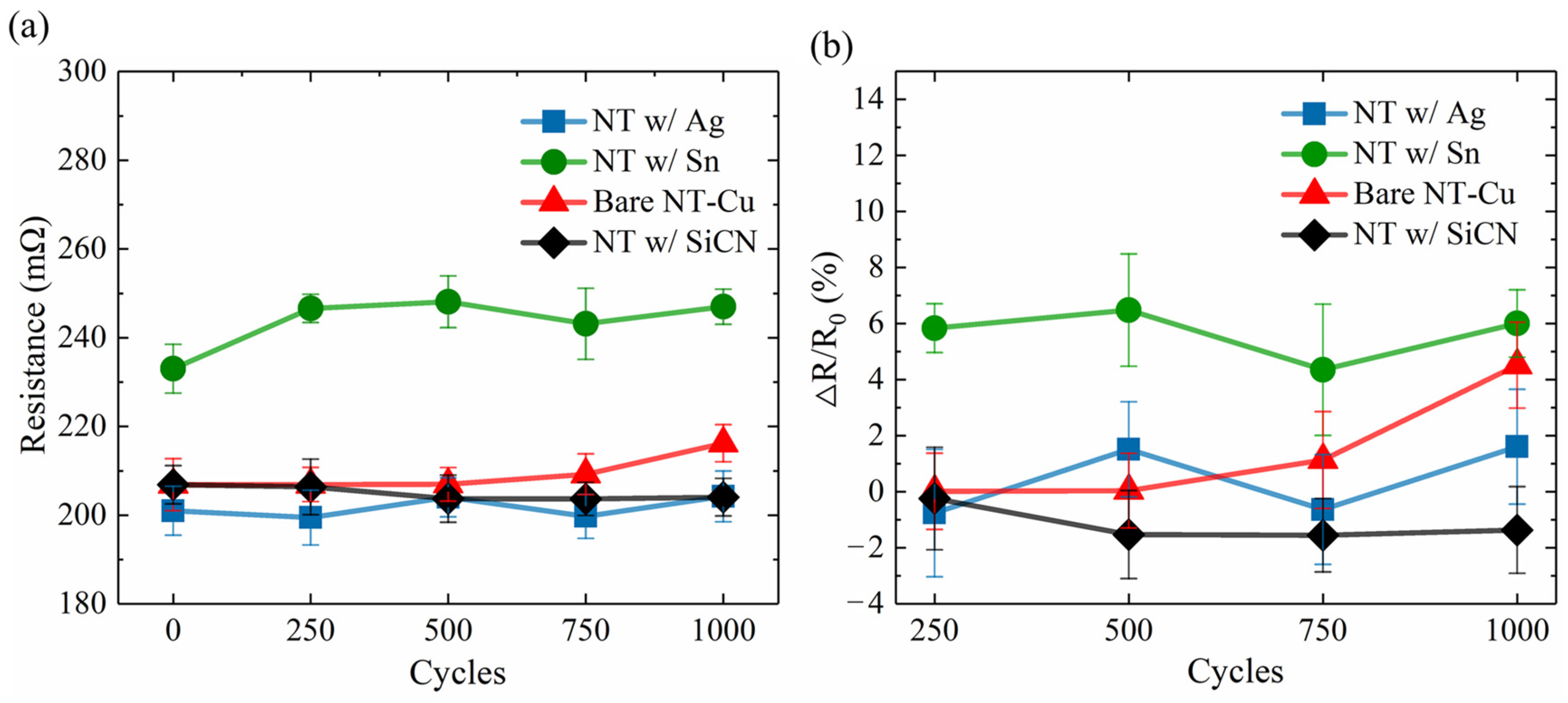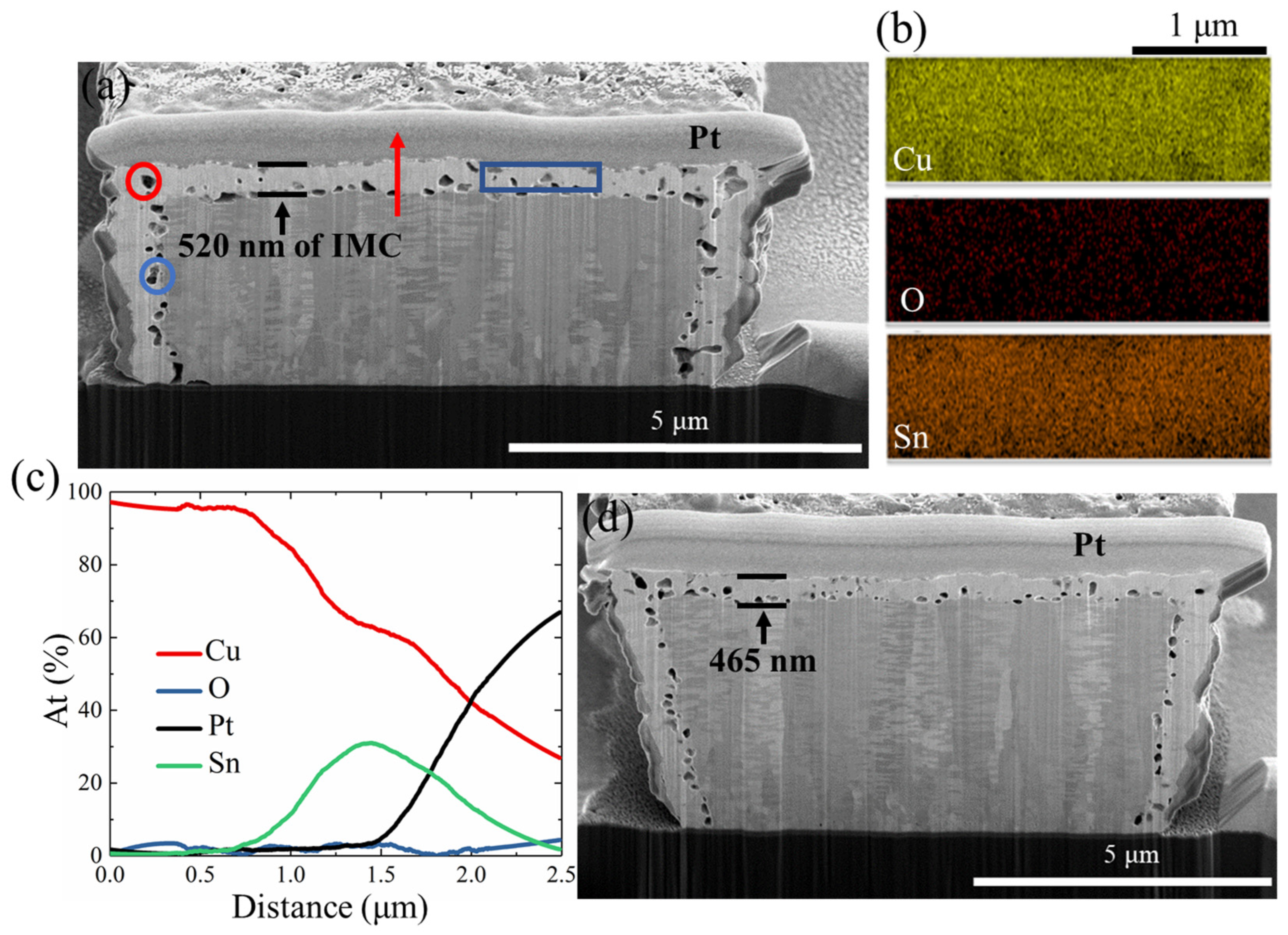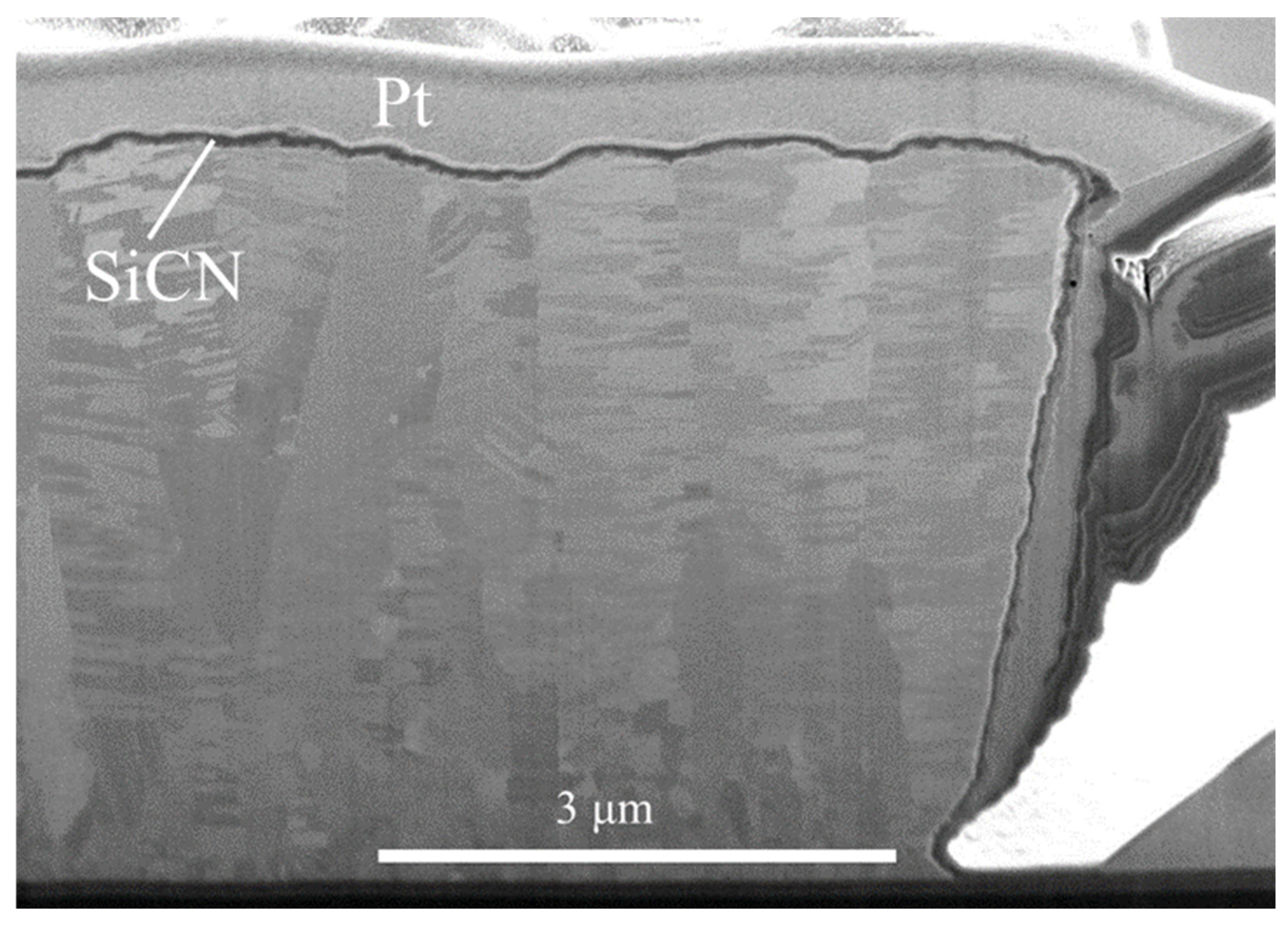Effect of Ag, Sn, and SiCN Surface Coating Layers on the Reliability of Nanotwinned Cu Redistribution Lines Under Temperature Cycling Tests
Abstract
:1. Introduction
2. Materials and Methods
3. Results and Discussion
4. Conclusions
Author Contributions
Funding
Data Availability Statement
Conflicts of Interest
References
- Savage, N. The race to the top among the world’s leaders in artificial intelligence. Nature 2020, 588, S102–S104. [Google Scholar] [CrossRef]
- Deng, S.G.; Zhao, H.L.; Fang, W.J.; Yin, J.W.; Dustdar, S.; Zomaya, A.Y. Edge intelligence: The confluence of edge computing and artificial intelligence. IEEE Internet Things J. 2020, 7, 7457–7469. [Google Scholar] [CrossRef]
- Chen, Z.; Zhang, J.; Wang, S.; Wong, C.-P. Challenges and prospects for advanced packaging. Fundam. Res. 2023. In Press, Corrected Proof. [Google Scholar] [CrossRef]
- Tummala, R.R. Moore’s law for packaging to replace Moore’s law for ICS. In Proceedings of the 2019 Pan Pacific Microelectronics Symposium (Pan Pacific), Kauai, HI, USA, 11–14 February 2019. [Google Scholar] [CrossRef]
- Lee, C.-H.; Hu, Y.; Chen, S.; Lai, C.; Liu, M.; Chen, H.; Lin, J.; Yew, M.; Hsu, C.; Chiu, M. Next generation large size high interconnect density CoWoS-R package. In Proceedings of the 2024 IEEE 74th Electronic Components and Technology Conference (ECTC), Denver, CO, USA, 28–31 May 2024. [Google Scholar] [CrossRef]
- Hou, S.Y.; Lee, C.H.; Wang, T.D.; Hou, H.C.; Hu, H.P. Supercarrier redistribution layers to realize ultra large 2.5D wafer scale packaging by CoWoS. In Proceedings of the 2023 IEEE 73rd Electronic Components and Technology Conference (ECTC), Orlando, FL, USA, 30 May–2 June 2023. [Google Scholar] [CrossRef]
- Pu, H.P.; Kuo, H.J.; Liu, C.S.; Yu, D.C.H. A novel submicron polymer re-distribution layer technology for advanced InFO packaging. In Proceedings of the 2018 IEEE 68th Electronic Components and Technology Conference (ECTC), San Diego, CA, USA, 29 May–1 June 2018. [Google Scholar] [CrossRef]
- Lau, J.; Tzeng, P.; Lee, C.; Zhan, C.; Li, M.; Cline, J.; Saito, K.; Hsin, Y.; Chang, P.; Chang, Y. Redistribution layers (RDLs) for 2.5 D/3D IC integration. J. Microelectron. Electron. Packag. 2014, 11, 16–24. [Google Scholar] [CrossRef]
- Lau, J.H. Recent advances and trends in chiplet design and heterogeneous integration packaging. J. Electron. Packag. 2024, 146, 010801. [Google Scholar] [CrossRef]
- Lianto, P.; Tan, C.W.; Peng, Q.J.; Jumat, A.H.; Dai, X.; Fung, K.M.P.; See, G.H.; Chong, S.C.; Ho, S.W.D.; Soh, S.B.S. Fine-pitch RDL integration for fan-out wafer-level packaging. In Proceedings of the 2020 IEEE 70th Electronic Components and Technology Conference (ECTC), Orlando, FL, USA, 26–29 May 2020. [Google Scholar] [CrossRef]
- Kudo, H.; Kasai, R.; Suyama, J.; Takeda, M.; Okazaki, Y.; Iida, H.; Kitayama, D.; Sakamoto, K.; Sato, H.; Yamada, S.; et al. Demonstration of high electromigration resistance of enhanced sub-2 micron-scale Cu redistribution layer for advanced fine-pitch packaging. In Proceedings of the 2017 IEEE CPMT Symposium Japan (ICSJ), Kyoto, Japan, 20–22 November 2017. [Google Scholar] [CrossRef]
- Liang, C.L.; Lin, Y.S.; Kao, C.L.; Tarng, D.; Wang, S.B.; Hung, Y.C.; Lin, G.T.; Lin, K.L. Electromigration reliability of advanced high-density fan-out packaging with fine-pitch 2-/2-μm L/S Cu redistribution lines. IEEE Trans. Compon. Pack. Manuf. Technol. 2020, 10, 1438–1445. [Google Scholar] [CrossRef]
- Li, Y.J.; Theng, C.H.; Tseng, I.H.; Chen, C.; Lin, B.; Chang, C.C. Highly (111)-oriented nanotwinned Cu for high fatigue resistance in fan-out wafer-level packaging. In Proceedings of the 2019 IEEE 69th Electronic Components and Technology Conference (ECTC), Las Vegas, NV, USA, 29–31 May 2019. [Google Scholar] [CrossRef]
- Wang, H.; Zhang, W.; Shi, Y.; Chen, S.; Fu, Z.; Yang, X.; Zhou, B. Investigation of the RDL reliability based on RF characterization. In Proceedings of the 2021 22nd International Conference on Electronic Packaging Technology (ICEPT), Xiamen, China, 14–17 September 2021. [Google Scholar] [CrossRef]
- Chen, K.X.; Gao, L.Y.; Li, Z.; Sun, R.; Liu, Z.Q. Research progress of electroplated nanotwinned copper in microelectronic packaging. Materials 2023, 16, 4614. [Google Scholar] [CrossRef]
- Zhang, M.H.; Gao, L.Y.; Li, J.J.; Sun, R.; Liu, Z.Q. Characterization of Cu-Cu direct bonding in ambient atmosphere enabled using (111)-oriented nanotwinned-copper. Mater. Chem. Phys. 2023, 306, 128089. [Google Scholar] [CrossRef]
- Sun, F.L.; Liu, Z.Q.; Li, C.F.; Zhu, Q.S.; Zhang, H.; Suganuma, K. Bottom-up electrodeposition of large-scale nanotwinned copper within 3D through silicon via. Materials 2018, 11, 319. [Google Scholar] [CrossRef]
- Sun, F.L.; Gao, L.Y.; Liu, Z.Q.; Zhang, H.; Sugahara, T.; Nagao, S.; Suganuma, K. Electrodeposition and growth mechanism of preferentially orientated nanotwinned Cu on silicon wafer substrate. J. Mater. Sci. Technol. 2018, 34, 1885–1890. [Google Scholar] [CrossRef]
- Anderoglu, O.; Misra, A.; Wang, H.; Ronning, F.; Hundley, M.F.; Zhang, X. Epitaxial nanotwinned Cu films with high strength and high conductivity. Appl. Phys. Lett. 2008, 93, 083108. [Google Scholar] [CrossRef]
- Yoo, B.G.; Boles, S.T.; Liu, Y.; Zhang, X.; Schwaiger, R.; Eberl, C.; Kraft, O. Quantitative damage and detwinning analysis of nanotwinned copper foil under cyclic loading. Acta Mater. 2014, 81, 184–193. [Google Scholar] [CrossRef]
- Li, N.; Wang, J.; Huang, J.Y.; Misra, A.; Zhang, X. Influence of slip transmission on the migration of incoherent twin boundaries in epitaxial nanotwinned Cu. Scr. Mater. 2011, 64, 149–152. [Google Scholar] [CrossRef]
- Anderoglu, O.; Misra, A.; Wang, J.; Hoagland, R.G.; Hirth, J.P.; Zhang, X. Plastic flow stability of nanotwinned Cu foils. Int. J. Plast. 2010, 26, 875–886. [Google Scholar] [CrossRef]
- Hsiao, H.Y.; Liu, C.M.; Lin, H.W.; Liu, T.C.; Lu, C.L.; Huang, Y.S.; Chen, C.; Tu, K.N. Unidirectional growth of microbumps on (111)-oriented and nanotwinned copper. Science 2012, 336, 1007–1010. [Google Scholar] [CrossRef] [PubMed]
- Tseng, I.H.; Hsu, P.N.; Lu, T.L.; Tu, K.N.; Chen, C. Electromigration failure mechanisms of ⟨111⟩ -oriented nanotwinned Cu redistribution lines with polyimide capping. Results Phys. 2021, 24, 104154. [Google Scholar] [CrossRef]
- Tseng, I.-H.; Hsu, P.-N.; Hsu, W.-Y.; Tran, D.-P.; Lin, B.T.-H.; Chang, C.-C.; Tu, K.; Chen, C. Effect of oxidation on electromigration in 2-µm Cu redistribution lines capped with polyimide. Results Phys. 2021, 31, 105048. [Google Scholar] [CrossRef]
- Lin, M.H.; Lin, Y.L.; Chen, J.M.; Yeh, M.S.; Chang, K.P.; Su, K.C.; Wang, T.H. Electromigration lifetime improvement of copper interconnect by cap/dielectric interface treatment and geometrical design. IEEE Trans. Electron Devices 2005, 52, 2602–2608. [Google Scholar] [CrossRef]
- Li, L.; Zhu, Z.; Yoon, A.; Wong, H.-S.P. In-situ grown graphene enabled copper interconnects with improved electromigration reliability. IEEE Electron Device Lett. 2019, 40, 815–817. [Google Scholar] [CrossRef]
- Hu, C.K.; Gignac, L.; Rosenberg, R.; Liniger, E.; Rubino, J.; Sambucetti, C.; Domenicucci, A.; Chen, X.; Stamper, A.K. Reduced electromigration of Cu wires by surface coating. Appl. Phys. Lett. 2002, 81, 1782–1784. [Google Scholar] [CrossRef]
- Chery, E.; Duval, F.F.; Stucchi, M.; Slabbekoorn, J.; Croes, K.; Beyne, E. Reliability study of polymers used in sub-4-μm pitch RDL applications. IEEE Trans. Compon. Packag. Manuf. Technol. 2021, 11, 1073–1080. [Google Scholar] [CrossRef]
- Chiu, T.-C.; Wu, J.-Y.; Liu, W.-T.; Liu, C.-W.; Chen, D.-L.; Shih, M.; Tarng, D. A mechanics model for the moisture induced delamination in fan-out wafer-level package. In Proceedings of the 2020 IEEE 70th Electronic Components and Technology Conference (ECTC), Orlando, FL, USA, 26–29 May 2020. [Google Scholar] [CrossRef]
- Stéphane, M.; Allouti, N.; Ribière, C.; Charbonnier, J.; Bouchu, D.; Michel, J.-P.; Buffet, N.; Chausse, P. Passivation materials for a reliable fine pitch RDL. In Proceedings of the 2018 IEEE 68th Electronic Components and Technology Conference (ECTC), San Diego, CA, USA, 29 May–1 June 2018. [Google Scholar] [CrossRef]
- Kudo, H.; Kasai, R.; Suyama, J.; Takeda, M.; Okazaki, Y.; Iida, H.; Kitayama, D.; Sasao, T.; Sakamoto, K.; Sato, H. Demonstration of high electrical reliability of sub-2 micron Cu traces covered with inorganic dielectrics for advanced packaging technologies. In Proceedings of the 2017 IEEE 67th Electronic Components and Technology Conference (ECTC), Orlando, FL, USA, 30 May–2 June 2017. [Google Scholar] [CrossRef]
- Qin, C.; Li, Y.; Mao, H. Effect of different PBO-based RDL structures on chip-package interaction reliability of wafer level package. IEEE Trans. Device Mater. Reliab. 2020, 20, 524–529. [Google Scholar] [CrossRef]
- Huang, C.L.; Weng, W.L.; Liao, C.N.; Tu, K.N. Suppression of interdiffusion-induced voiding in oxidation of copper nanowires with twin-modified surface. Nat. Commun. 2018, 9, 340. [Google Scholar] [CrossRef]
- Nakamura, R.; Tokozakura, D.; Nakajima, H.; Lee, J.G.; Mori, H. Hollow oxide formation by oxidation of Al and Cu nanoparticles. J. Appl. Phys. 2007, 101, 074303. [Google Scholar] [CrossRef]
- Tu, K.-N. Solder Joint Technology; Springer: New York, NY, USA, 2007; Volume 117. [Google Scholar]
- Chen, C.; Yu, D.; Chen, K.N. Vertical interconnects of microbumps in 3D integration. MRS Bull. 2015, 40, 257–262. [Google Scholar] [CrossRef]
- Lin, K.; Ling, H.Q.; Hu, A.M.; Wu, Y.W.; Gao, L.M.; Hang, T.; Li, M. Growth behavior and formation mechanism of porous Cu3Sn in Cu/Sn solder system. Mater. Charact. 2021, 178, 111271. [Google Scholar] [CrossRef]
- Kumar, S.; Handwerker, C.A.; Dayananda, M.A. Intrinsic and Interdiffusion in Cu-Sn System. J. Phase Equilib. Diffus. 2011, 32, 309–319. [Google Scholar] [CrossRef]
- Glazer, J. Microstructure and mechanical properties of Pb-free solder alloys for low-cost electronic assembly: A review. J. Electron. Mater. 1994, 23, 693–700. [Google Scholar] [CrossRef]
- Wei, C.C.; Chen, C.F.; Liu, P.C.; Chen, C. Electromigration in Sn-Cu intermetallic compounds. J. Appl. Phys. 2009, 105, 023715. [Google Scholar] [CrossRef]









Disclaimer/Publisher’s Note: The statements, opinions and data contained in all publications are solely those of the individual author(s) and contributor(s) and not of MDPI and/or the editor(s). MDPI and/or the editor(s) disclaim responsibility for any injury to people or property resulting from any ideas, methods, instructions or products referred to in the content. |
© 2024 by the authors. Licensee MDPI, Basel, Switzerland. This article is an open access article distributed under the terms and conditions of the Creative Commons Attribution (CC BY) license (https://creativecommons.org/licenses/by/4.0/).
Share and Cite
Hung, Y.-W.; La, M.-P.; Lin, Y.-Q.; Chen, C. Effect of Ag, Sn, and SiCN Surface Coating Layers on the Reliability of Nanotwinned Cu Redistribution Lines Under Temperature Cycling Tests. Materials 2024, 17, 5458. https://doi.org/10.3390/ma17225458
Hung Y-W, La M-P, Lin Y-Q, Chen C. Effect of Ag, Sn, and SiCN Surface Coating Layers on the Reliability of Nanotwinned Cu Redistribution Lines Under Temperature Cycling Tests. Materials. 2024; 17(22):5458. https://doi.org/10.3390/ma17225458
Chicago/Turabian StyleHung, Yu-Wen, Mai-Phuong La, Yi-Quan Lin, and Chih Chen. 2024. "Effect of Ag, Sn, and SiCN Surface Coating Layers on the Reliability of Nanotwinned Cu Redistribution Lines Under Temperature Cycling Tests" Materials 17, no. 22: 5458. https://doi.org/10.3390/ma17225458
APA StyleHung, Y.-W., La, M.-P., Lin, Y.-Q., & Chen, C. (2024). Effect of Ag, Sn, and SiCN Surface Coating Layers on the Reliability of Nanotwinned Cu Redistribution Lines Under Temperature Cycling Tests. Materials, 17(22), 5458. https://doi.org/10.3390/ma17225458






